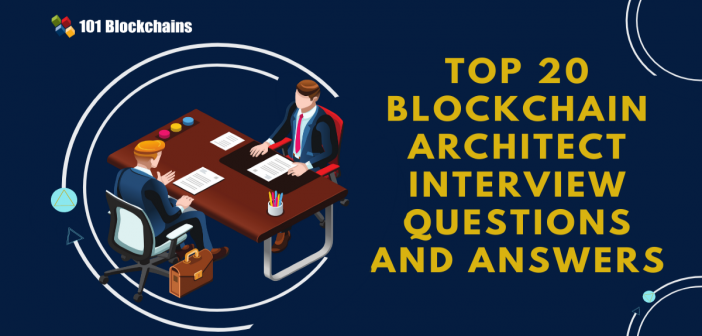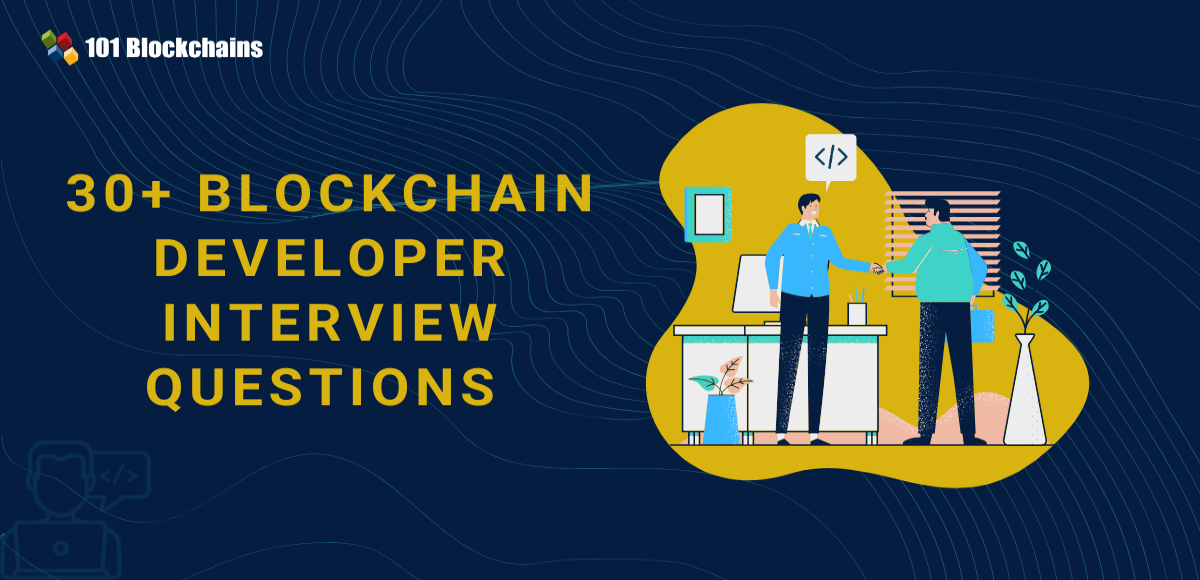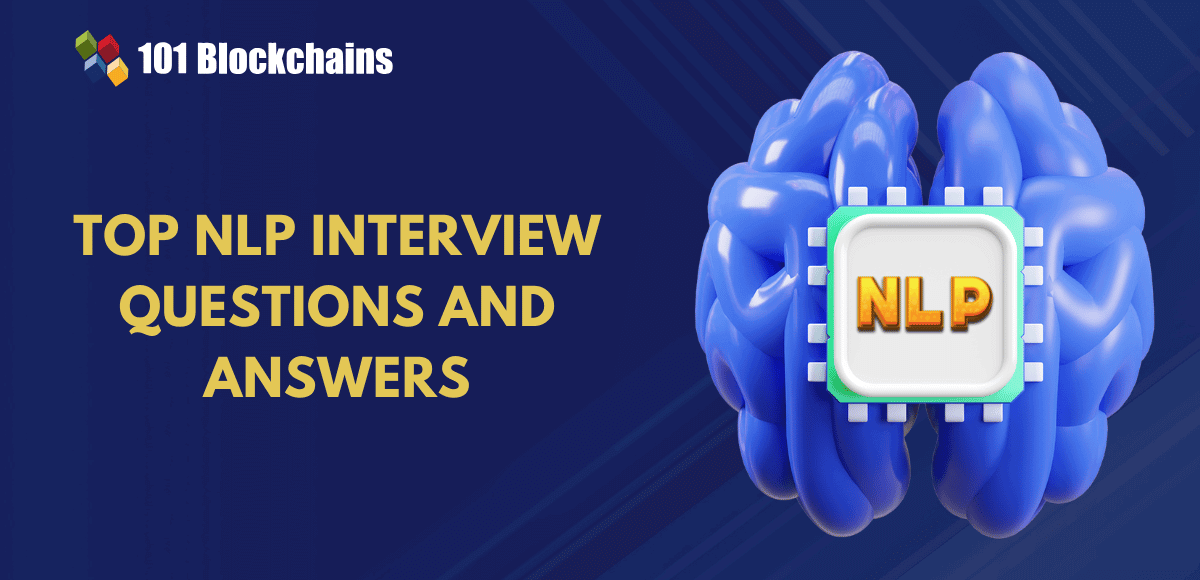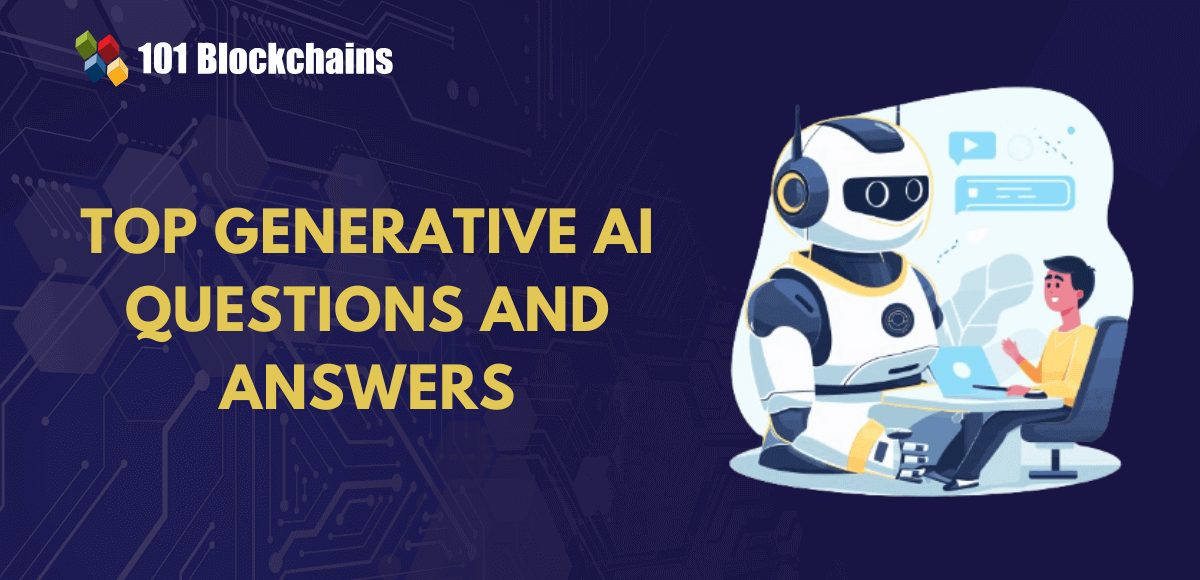Learn how blockchain truly works, master key definitions, and uncover what makes smart contracts so "smart." Dive into the fundamentals, gain valuable insights, and start your blockchain journey today!

- Interview Preparation
Diego Geroni
- on February 16, 2021
Top 20 Blockchain Architect Interview Questions and Answers
Preparing for a blockchain architect interview? Here we bring the expert guide that will cover the top blockchain architect interview questions for your preparation!
The hype around blockchain technology is slowly subsiding, and cryptocurrencies are associated with falling prices. However, blockchain jobs continue to gain radical momentum across different sectors, with companies realizing the business value of blockchain. So, many candidates often look for blockchain architect interview questions to prepare for professional blockchain-based job roles.
The blockchain architect job role is one of the most sought-after job roles in the blockchain landscape. Since the job role of a blockchain architect involves core responsibilities, the top blockchain architect interview questions would focus on technical fluency of candidates. So, where can you find the latest blockchain architect interview questions to increase your chances of qualifying for a lucrative career with blockchain technology? Here’s our comprehensive guide to help you out.
Top Blockchain Architect Interview Questions
One of the foremost concerns in the mind of any blockchain architect interview candidate refers to complexity of questions. However, candidates should note that the basic blockchain architect interview questions start with the fundamental concepts. Interviewers generally ask questions that test the candidate’s basic knowledge regarding blockchain. Here are some of the most popular blockchain architect interview questions that you can come across in the initial stages.
1. What Is the Difference Between Hyperledger And Blockchain?
Blockchain is defined as a decentralized technology with various immutable records, known as blocks. On the other hand, Hyperledger serves as a platform for enabling people to develop their private blockchains. Hyperledger is only suitable for enterprise-oriented solutions. On the other hand, blockchain is applicable across various sectors apart from business, including healthcare and governance. Hyperledger allows users to build private blockchains only, while blockchain offers the flexibility of choosing between private and public blockchain.
Want to learn the basic and advanced concepts of Blockchain and Hyperledger Fabric? Enroll Now: Getting Started with Hyperledger Fabric Course
2. What is Merkel Tree?
Merkel Tree is one of the significant elements in blockchain technology for verification of a block. It is basically a data structure, with the appearance of a binary tree that houses cryptographic hashes in each block. The binary tree structure in Merkel Trees present the hash of a block of transactional data as a leaf node. On the other hand, the non-leaf nodes serve as the hash of leaf node. Subsequently, the Merkel root or hash root represents the final hash root for all transaction hashes, including all the transactions in the non-leaf nodes.
3. Define the Significance of Cryptography in Blockchain
Cryptography would be one of the top entries among blockchain architect interview questions. Hashing in cryptography can help in supporting the security of the identities of users. It also ensures the safe execution of transactions through a hash function. Blockchain employs the SHA-256 cryptography protocol with the facility of the unique hash output for all inputs. The SHA-256 algorithm provides standard alphanumeric output comprising of 64 characters, irrespective of the input.
4. Define the Genesis Block
The genesis block is also one of the notable topics for fundamental blockchain architect interview questions. More so, the genesis block, as the name implies, is the first block in a blockchain, and it is also referred to as block 0. The genesis block is the only block in a blockchain that does not refer to the previous block. Subsequently, the genesis block can also help in defining different blockchain parameters such as consensus algorithms and difficulty level.
5. What Are Some of The Popular Cryptographic Algorithms?
Some of the most notable cryptographic algorithms include SHA-256, Blowfish, RSA, Ethash, and Triple DES.
6. What Are the Popular Open-Source Platforms for Blockchain Application Development?
The most notable open-source platforms that can help in developing blockchain applications include Ethereum, Hyperledger, Eris, Open chain, and Multichain.
Ethereum is presently the most popular alternative for developing blockchain applications. Enterprise Ethereum is also popular among enterprises for developing business grade blockchain solutions.
On the other hand, Eris is a popular choice for developing enterprise blockchain solutions.
Build your identity as a certified blockchain expert with 101 Blockchains’ Blockchain Certifications designed to provide enhanced career prospects.
7. Why Did You Choose Blockchain For Application Development?
The reasons for using blockchain will also serve as one of the notable blockchain architect interview questions. As a matter of fact, a blockchain is a reliable approach to the grounds of various reasons. First of all, blockchain is highly compatible with various business applications on the basis of its open-source nature. Blockchain business models also offer comprehensive security to facilitate secure information exchange and transactions. Furthermore, blockchain is suitable for businesses of all sizes with the assurance of on-demand scalability.
8. What Are the Key Features That You Can Find in Blockchain Technology?
The top blockchain features include the following,
- Decentralized nature
- Distributed ledger
- A secure ecosystem with better assurance of integrity
9. What Is the Role of Blocks in Blockchain?
You are most likely to come across this entry among blockchain architect interview questions without any doubts. Blockchain is basically a chain of ‘blocks’ or collection of records. The blocks are then linked with each other, thereby forming a chain, which we knew as blockchain. Users can recognize a block in the online ledger through its hash pointer. The hash pointer serves as the link for the block before the concerned block. In addition, a block also contains transaction data alongside a time stamp. And it’s also responsible for determining the blockchain size.
10. Do You Know Anything About Block Identifiers?
Block identifiers in blockchain include the block height and the block header hash, which help in identifying a block.
Aspiring to level up your career with one of the best blockchain certifications? Check how you can become a Certified Enterprise Blockchain Architect.
11. Name the Type of Records for Storing Records on Blockchain
Blockchain does not impose any restriction on the type of records suitable for storage. Companies across various industries are presently employing blockchain for the security of different types of records. Generally, blockchain helps in storing records such as transaction processing, management activities, identity management, documentation, and medical transaction records.
12. Explain About Forking in Blockchain
Forking is a common topic in the most popular blockchain architect interview questions for experts. Basically, forking is the process of updating a cryptocurrency code or protocol. During the process, a blockchain is divided into two branches. Forking is generally inevitable when network participants cannot arrive at an agreement regarding new rules and consensus algorithms for validating transactions. Users can find three common variants of forking such as soft forks, hard forks, and accidental forks.
13. Define Nonce and Its Application in Mining
Nonce is also one of the common topics you may come across in blockchain architect interview questions. Mining is an essential requirement for proving transactions through the resolution of a mathematical puzzle, known as proof of work. Blockchain proof of work helps in determining a nonce or a number alongside a cryptographic hash algorithm. Both the nonce and the hash algorithm produce a lower hash value than the predefined target. So, the nonce is basically a random value that helps in adjusting hash value for maintaining similarity between hash conditions and final hash value.
Curious to learn about blockchain implementation and strategy for managing your blockchain projects? Enroll Now in Blockchain Technology – Implementation And Strategy Course!
14. How Is A Public Key Different from Private Key?
The private key is suitable for encryption or locking of a message or transaction sent over the blockchain network. In this case, the sender could send messages by using the receiver’s public key. Then, the receiver could decrypt the transaction or message by leveraging their private key. As a result, the communication or transaction stays safe from any threats of tampering.
Curious about the difference between a public and a private key? Here’s a guide to private key vs public key that you can check out.
15. What Are Some of The Top Applications of Smart Contracts?
The most notable applications of smart contracts include tracking of goods shipments, insurance applications, and protection of ownership rights. Smart contracts can also serve as favorable instruments ensuring wage payments.
16. What Is the Process for Generating A Block Signature or Hash?
Blockchain architect interview questions would also focus on the process for generating the block signature. The process starts by entering transaction details through a unidirectional hash function such as SHA-256. Then, users have to run the output value by leveraging a signature algorithm such as ECDSA with private key of user. Now, you can get the encrypted hash as well as other pieces of information, such as the hashing algorithm.
17. What Is the Outcome of Deploying A File with Multiple Contracts?
Users cannot deploy a file with multiple contracts on blockchain. The compiler only considers the last contract from the uploaded file for deployment, alongside neglecting the other contacts.
Start your blockchain journey Now with the Enterprise Blockchains Fundamentals
18. Is It Possible to Remove A Whole Block from A Blockchain Network?
Yes, users can remove a complete block from a blockchain network. This is applicable in situations where you have to focus only on a specific aspect of the online ledger. Most important of all, you can find various default filters and options for removing a complete block.
19. Define Coinbase Transaction?
Coinbase transaction refers to the first transaction happening in a block. Miners can create this unique variant of Bitcoin transactions for collecting block reward for their contribution. Miners can also collect other transaction fees collected by the miner.
20. What Are the Notable Variants of Consensus Algorithms?
The most common variants of consensus algorithms include the following,
- Proof of Work
- Proof of Stake
- Byzantine Fault Tolerance
- Proof of Elapsed Time
- Proof of Authority
- Delegated Proof of Stake
Start learning Blockchain with World’s first Blockchain Career Paths with quality resources tailored by industry experts Now!
Conclusion
On a final note, you can clearly observe the types of blockchain architect interview questions. The chances of success of a candidate in blockchain architect interview questions depend considerably on their subject matter expertise. Apart from your knowledge and skills in blockchain architecture, you would need business-centric skills to achieve value.
Although blockchain architect interviews appear easy for trained and certified candidates, there is a lot more to consider for interviews. You need to develop the right amount of focus and concentration to clear all questions with confidence. You can also get your hands on one of the best blockchain certifications that validate your skills and expertise. It will give you an extra advantage in the interview and you will be given a higher priority among other candidates.
So, this is the right time to hone your blockchain skills and knowledge with reliable blockchain education and certification platforms.
*Disclaimer: The article should not be taken as, and is not intended to provide any investment advice. Claims made in this article do not constitute investment advice and should not be taken as such. 101 Blockchains shall not be responsible for any loss sustained by any person who relies on this article. Do your own research!






